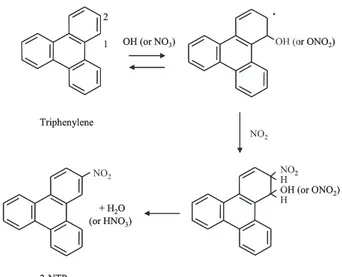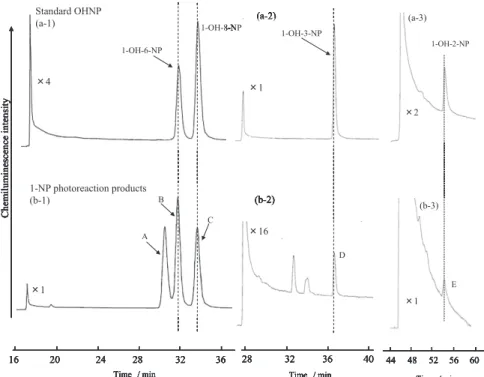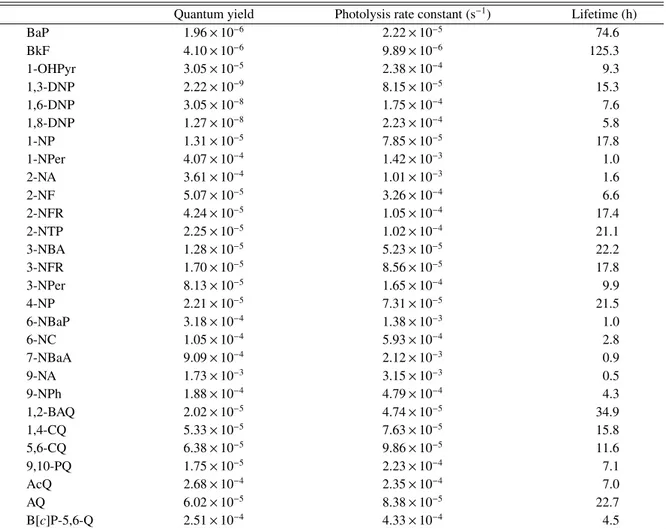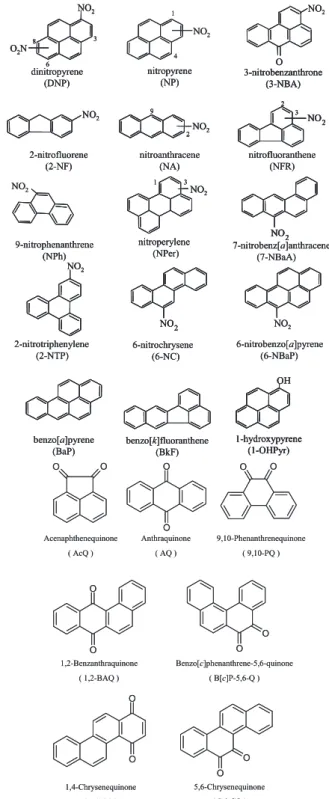Atmospheric Chemistry of Polycyclic Aromatic Hydrocarbons and Related Compounds
全文
(2) No. 6. of 2-NTP to the mutagenicity of airborne particles could be significant. From a public hygienic point of view, the acquisition of more detailed data about the environmental occurrence of NTPs is of great importance. Thus, the formation of 1nitrotriphenylene (1-NTP) and 2-NTP by gas-phase OH or NO3 radical-initiated reaction of triphenylene was demonstrated using a flow reaction system.17) Nitration of triphenylene with N2 O5 in CCl4 was also examined in order to determine the isomer distribution of NTPs formed via NO3 radicalinitiated nitration of triphenylene and in order to predict rate constants of the gas-phase OH or NO3 radical-initiated reactions of triphenylene. The formation of 1- and 2-NTP was clearly shown by HPLC analysis of the products of the gasphase reaction of triphenylene initiated by the OH radicals. A 2-NTP/1-NTP ratio of 1.22 was obtained for OH radical-initiated nitration. In contrast, the NO3 radical-initiated reaction predominantly gave 2-NTP, with traces of 1-NTP. Since the amount of 1-NTP formed in the NO3 radicalinitiated reaction was too small to determine, a precise 2-NTP/1-NTP value could not be calculated and was thus assumed to be a value greater than 1.5. Preferential production of 2-NTP was also observed in the nitration of triphenylene with N2 O5 in CCl4 ; the yields of 1- and 2-NTP were 6 ± 2% and 35 ± 2%, respectively. It has been reported that the reactions of several kinds of PAH with N2 O5 in CCl4 are similar in terms of nitro-isomer distribution to gasphase NO3 radical-initiated nitration.18, 19) Thus, the analogous isomer distribution of NTP (the larger yield of 2-NTP than 1-NTP) in the gas-phase reaction to that in CCl4 liquid-phase nitration does not contradict previous findings regarding the nitration of PAH. The mean 2-NTP/1-NTP ratio in samples of airborne particles was > 1.55; this value was similar to the values from the radical-initiated reactions and was much higher than that of the diesel exhaust particulate (DEP) samples (2-NTP/1-NTP = 0.37). This finding indicates that the atmospheric radicalinitiated reactions significantly contribute to formation of airborne NTPs, especially 2-NTP. Gas-phase formation of nitro-PAHs via OH or NO3 radicalinitiated reaction involves the addition of an OH or NO3 radical to PAH at the carbon atom with the highest electron density, followed by ortho-addition of NO2 , resulting in loss of water or nitric acid. For triphenylene, the carbon at the 1-position is the most electron-rich;20, 21) therefore, preferential formation of 2-NTP over 1-NTP is expected in the gas-phase. 505. Fig. 1. Scheme of Formation of 2-NTP from OH or NO3 Radical-initiated Reactions of Triphenylene. radical-initiated reaction (Fig. 1). The rate constants of gas-phase reactions of triphenylene with OH and NO3 radicals at 298 K were predicted to be (8.6 ± 1.2) × 10−12 cm3 molecule−1 s−1 and (6.6 ± 1.5) × 10−29 [NO2 ] cm3 molecule−1 s−1 , respectively using a relativerate method in a CCl4 liquid phase-system.22) Based on the ambient concentration of 2-NTP and the obtained rate constant for the reaction of triphenylene with the radicals, the atmospheric loss rate of 2NTP relative to 2-NFR, which is the most abundant NPAH and is also produced from the radical reactions, was successfully estimated, i.e. 2-NTP is less susceptible to decomposition than 2-NFR under ambient conditions.. ATMOSPHERIC FORMATION OF HYDROXYNITROPYRENES FROM A PHOTOCHEMICAL REACTION OF PARTICLE-ASSOCIATED 1-NP 1-NP, one of the most abundant NPAHs in the atmosphere, is a representative NPAH formed through combustion of fossil fuels such as diesel fuel. 1-NP taken up by humans and animals is transformed to various metabolites such as hydroxynitropyrenes (OHNPs) in the presence of cytochrome P450 enzymes.23) Several isomers of OHNP (Fig. 2), such as 1-hydroxy-3-nitropyrene (1OH-3-NP), 1-hydroxy-6-nitropyrene (1-OH-6-NP), and 1-hydroxy-8-nitropyrene (1-OH-8-NP) have also been observed in airborne particles24, 25) and.
(3) 506. Vol. 57 (2011). DEP.1, 26, 27) Several studies have found that most OHNP isomers have lower mutagenic activity than the parent 1-NP.23, 27, 28) Recently, however, OHNPs such as 1-OH-3-NP, 1-OH-6-NP, and 1-OH-8-NP have been found to act as endocrine disruptors, i.e. they act as estrogenic, anti-estrogenic, and anti-androgenic compounds,29, 30) which may cause dysfunction of human and wildlife endocrine systems, abnormal development of reproductive systems, and immunodeficiencies. In view of the influence of OHNPs on human health, we need to learn more about their environmental concentration levels, sources and behavior. Therefore, the formation of OHNPs including 1-OH-3-NP, 1-OH-6-NP, and 1-OH-8-NP from photochemical reactions of 1-NP was examined by laboratory experiments in order to clarify the occurrence of atmospheric OHNPs.31) Figure 3 shows a profile of HPLC analysis with. Fig. 2. Structure of Hydroxynitropyrene. chemiluminescence detection (HPLC/CLD) for the products from photoreactions of 1-NP in methanol. Five chromatographic peaks were observed in the chromatogram as symbolized by A, B, C, D, and E. The retention times of peaks B, C, D, and E were the same as those of authentic 1-OH-6-NP, 1-OH-8-NP, 1-OH-3-NP, and 1-hydroxy-2-nitropyrene (1-OH-2NP), respectively. When analyzed by LC/MS/MS, a fraction containing the photo-reaction products also yielded five peaks. By comparing the retention times and the MS/MS spectra of these peaks with those of the authentic standards, four known OHNPs, 1-OH-2-NP, 1-OH-3-NP, 1-OH-6-NP, and 1-OH-8-NP, were identified. For these compounds, the molecular-related ion m/z 262 ([M-H]− ) together with the characteristic fragment ions m/z 232 ([M-H-NO]− ) and 216 ([M-H-NO2 ]− ) were detected in a full scan analysis. 1-OH-3-NP, 1-OH6-NP, and 1-OH-8-NP were found in 1-NP photoreaction products for the first time in the study. The unknown compound that was observed in the HPLC/CLD chromatogram was also observed in the LC/MS/MS analysis. This compound also gave a characteristic MS/MS spectrum with a molecularrelated ion m/z 262 and fragment ions m/z 232 and m/z 216. The similarity between the fragmentation patterns of the unknown compound and known OHNPs indicates that the unknown compound is. Fig. 3. Chromatograms of Standard OHNPs (a) and Photoreaction Products of 1-NP (b) Obtained by the HPLC-chemiluminescence Detection System.
(4) 507. No. 6. an isomer of OHNP. The structure of the unknown compound obtained by the preparative scale photoreaction was then determined by analysis of its 1 H-NMR spectrum. On the basis of chemical shifts and coupling patterns, the unknown compound contained in the photo-reaction products was identified as 1-hydroxy-5-nitropyrene (1-OH-5-NP). All the OHNP isomers, which were found in the 1-NP photo-reaction products, were also identified in ambient airborne particles collected at a typical residential area in Osaka, Japan. 1-OH-2NP and 1-OH-5-NP were identified in ambient airborne particles for the first time. On the contrary, these two OHNP isomers were not found in Standard Reference Materials (SRM) 1650b and SRM 1975, which are typical DEP samples. The concentrations of the other OHNP isomers in the DEP samples were much lower than the concentration of 1NP. On the other hand, significantly higher concentration ratios of ΣOHNP (= 1-OH-3-NP + 1-OH-6NP + 1-OH-8-NP) to 1-NP were observed in ambi-. ent airborne particles than in the DEP samples. In ambient airborne particles, the mean ΣOHNP/1-NP concentration ratio of 1.4 was 35 times higher than that in SRM 1650b and 470 times higher than that in SRM 1975. The diurnal concentration of 1-NP, which was observed at the site in Osaka, Japan, increased early in the morning and late in the evening, suggesting that automotive emissions contributed to the occurrence of 1-NP. The OHNP concentrations also rose in the morning and variations of OHNP concentrations similar to those of 1-NP were observed during the daytime. However, the concentrations of OHNPs did not increase in the evening rush hour, and were low at night, i.e. in the absence of sunlight. These results support the idea that atmospheric OHNPs are predominantly formed via secondary formation processes, i.e. photochemical reactions of 1-NP are expected to have a significant effect on the occurrence of OHNPs in the atmosphere.. Table 1. Quantum Yield, Photolysis Rate Constant, and Estimated Lifetime of the PAH Derivatives on the Earth’s Surface BaP BkF 1-OHPyr 1,3-DNP 1,6-DNP 1,8-DNP 1-NP 1-NPer 2-NA 2-NF 2-NFR 2-NTP 3-NBA 3-NFR 3-NPer 4-NP 6-NBaP 6-NC 7-NBaA 9-NA 9-NPh 1,2-BAQ 1,4-CQ 5,6-CQ 9,10-PQ AcQ AQ B[c]P-5,6-Q. Quantum yield 1.96 × 10−6 4.10 × 10−6 3.05 × 10−5 2.22 × 10−9 3.05 × 10−8 1.27 × 10−8 1.31 × 10−5 4.07 × 10−4 3.61 × 10−4 5.07 × 10−5 4.24 × 10−5 2.25 × 10−5 1.28 × 10−5 1.70 × 10−5 8.13 × 10−5 2.21 × 10−5 3.18 × 10−4 1.05 × 10−4 9.09 × 10−4 1.73 × 10−3 1.88 × 10−4 2.02 × 10−5 5.33 × 10−5 6.38 × 10−5 1.75 × 10−5 2.68 × 10−4 6.02 × 10−5 2.51 × 10−4. See Fig. 4 for compound abbreviations.. Photolysis rate constant (s−1 ) 2.22 × 10−5 9.89 × 10−6 2.38 × 10−4 8.15 × 10−5 1.75 × 10−4 2.23 × 10−4 7.85 × 10−5 1.42 × 10−3 1.01 × 10−3 3.26 × 10−4 1.05 × 10−4 1.02 × 10−4 5.23 × 10−5 8.56 × 10−5 1.65 × 10−4 7.31 × 10−5 1.38 × 10−3 5.93 × 10−4 2.12 × 10−3 3.15 × 10−3 4.79 × 10−4 4.74 × 10−5 7.63 × 10−5 9.86 × 10−5 2.23 × 10−4 2.35 × 10−4 8.38 × 10−5 4.33 × 10−4. Lifetime (h) 74.6 125.3 9.3 15.3 7.6 5.8 17.8 1.0 1.6 6.6 17.4 21.1 22.2 17.8 9.9 21.5 1.0 2.8 0.9 0.5 4.3 34.9 15.8 11.6 7.1 7.0 22.7 4.5.
(5) 508. Vol. 57 (2011). PHOTOCHEMICAL DECOMPOSITION OF SELECTED NITRO- AND OXY-PAHS ON AIRBORNE PARTICLES UNDER SIMULATED SOLAR UV-IRRADIATION As in the case of 1-NP, photoinduced decomposition is a dominant pathway for the degradation of particle-associated PAH derivatives.32, 33) Solar radiation in UV region can modify PAH derivatives to form new compounds, which may exhibit different types of biological effects such as disruption of endocrine systems and production of reactive oxygen species (ROS) in human body.34) Thus, it is necessary to understand the photodecomposition of PAH derivatives in order to understand their effects on humans. However, the rate constants and the quantum yields regarding the photolysis of the derivatized PAHs, which are the most significant factors for the photodecomposition, had not been studied well. Thus, photodecomposition experiments for selected OPAHs and NPAHs including 3nitrobenzanthrone (3-NBA), a nitrated aromatic ketone that is strongly mutagenic,35) were conducted on a glass surface as a simple model of airborne particles and the photolysis rate constants and the quantum yields for the PAHs derivatives in the system were determined.36) Furthermore, the atmospheric lifetime of the compounds due to photodecomposition was estimated using the actinic flux on the earth’s surface, photolysis rate constants, and quantum yields obtained in the study. The largest photolysis rate constant was observed for 9-nitroanthracene (9-NA), while 4nitropyrene (4-NP) and 3-NBA were found the most stable of the nitrated compounds under UVirradiation (Table 1). It is hypothesized that photoreactivity of NPAHs is governed by the orientation of the nitro group, i.e. NPAHs having perpendicular nitro groups are more easily photodecomposed than those having parallel ones.12, 37) The fast photodegradation observed for 9-NA, 6-nitrobenzo[a]pyrene (6-NBaP), and 7nitrobenz[a]anthracene (7-NBaA), which have a perpendicular nitro group, was consistent with the hypothesis (Fig. 4). The photoreaction products of NPAHs were reported to include quinoid PAHs,12) as well as photoreaction products of PAHs. Benzo[c]phenanthrene-5,6-quinone (B[c]P5,6-Q) which has a similar photolysis rate constant to 9-nitrophenanthrene (9-NPh) degraded the fastest of the seven OPAHs we tested. 1,2-. Fig. 4. Structures of PAH Derivatives Examined in the Photodecomposition Experiment. Benzanthraquinone (1,2-BAQ) was the most resistant to photodecomposition of all the substituted PAHs examined in the study. Although previous studies for the photostability of OPAHs were quite limited, Cvrˇekov´a and Ciganek reported that 9,10phenanthraquinone (9,10-PQ) was less stable than.
(6) 509. No. 6. anthraquinone (AQ) under UV irradiation,38) that is consistent with our results. Photolysis rate constants of the tested compounds under irradiation of sunlight were estimated based on the actinic flux on the earth’s surface 39) and the quantum yields obtained in the study. Atmospheric lifetimes of the compounds due to photodecomposition were calculated to be 0.5–22 hr for NPAHs and 4.5–35 hr for OPAHs using the obtained photolysis rate constants. OPAHs were found to be more stable against photo irradiation than NPAHs. This finding indicates that the risk induced by OPAHs is critical for human health, because we may be continuously exposed by OPAHs due to their longer residence time in the atmosphere. Recently, it has been found that ROS, which can cause severe oxidative stress connected with inflammatory processing, are produced in larger amounts via chain reactions induced by quinoid PAHs in the human body.34) Further studies on the biological effects and the atmospheric formation and decomposition mechanisms for OPAHs are required. Acknowledgements These researches were supported by The Ministry of Education, Culture, Sports, Science and Technology (MEXT)/Japan Society for the Promotion of Science (JSPS) Grant-inAid for Scientific Research (21200031, 22510010, 20710003), the Sumitomo Foundation (073150), and the Environment Research and Technology Development Fund (RF-0905) of the Ministry of the Environment, Japan. I thank Prof. Kazuichi Hayakawa of Kanazawa University and Prof. Hiroshi Bandow of Osaka Prefecture University for helpful discussion and kind support throughout my works.. 5). 6). 7). 8). 9). 10). 11). 12). REFERENCES 1) Schuetzle, D. (1983) Sampling of vehicle emissions for chemical analysis and biological testing. Environ. Health Perspect., 47, 65–80. 2) Salmeen, I. T., Pero, A. M., Zator, R., Schuetzle D. and Riley, T. L. (1984) Ames assay chromatograms and the identification of mutagens in diesel particle extracts. Environ. Sci. Technol., 18, 375–382. 3) Schuetzle, D., Riley, T. L., Prater, T. J., Harvey, T. M. and Hunt, D. F. (1982) Analysis of nitrated polycyclic aromatic-hydrocarbons in diesel particulates. Anal. Chem., 54, 265–271. 4) Bamford, H. A., Bezabeh, D. Z., Schantz, M. M.,. 13). 14). 15). Wise, S. A. and Baker, J. E. (2003) Determination and comparison of nitrated-polycyclic hydrocarbons measured in air and diesel particulate reference materials. Chemosphere, 50, 575–587. Bezabeh, D. Z., Bamford, H. A., Schantz, M. M. and Wise, S. A. (2003) Determination of nitrated polycyclic aromatic hydrocarbons in diesel particulaterelated standard reference materials by using gas chromatography/mass spectrometry with negative ion chemical ionization. Anal. Bioanal. Chem., 375, 381–388. Zielinska, B., Arey, J., Atkinson, R., Ramdahl, T. and Winer, A. M. (1989) The nitroarenes of molecular weight 247 in ambient particulate samples collected in southern California. Atmos. Environ., 23, 223–229. Ciccioli, P., Cecinato, A., Brancaleoni, E., Frattoni, M., Zacchei, P., Miguel, A. H. and de Castro Vasconcellos, P. (1996) Formation and transport of 2nitrofluoranthene and 2-nitropyrene of photochemical origin in the troposphere. J. Geophys. Res., 101, 19567–19581. Reisen, F. and Arey, J. (2005) Atmospheric reactions influence seasonal PAH and nitro-PAH concentrations in the Los Angeles basin. Environ. Sci. Technol., 39, 64–73. Atkinson, R. and Arey, J. (1994) Atmospheric chemistry of gas-phase polycyclic aromatic hydrocarbons: formation of atmospheric mutagens. Environ. Health Perspect., 102, 117–126. Sasaki, J., Aschmann, S. M., Kwok, E. S. C., Atkinson, R. and Arey, J. (1997) Products of the gas-phase OH and NO3 radical-initiated reactions of naphthalene. Environ. Sci. Technol., 31, 3173–3179. ˇ Cvrˇekov´a, O., Ciganek, M. and Simek, Z. (2006) Anthracene, chrysene, their nitro- and methylderivatives photostability in isooctane. Polycycl. Aromat. Compd., 26, 331–344. Warner, S. D., Farant, J.-P. and Butler, I. S. (2004) Photochemical degradation of selected nitropolycyclic aromatic hydrocarbons in solution and adsorbed to solid particles. Chemosphere, 54, 1207– 1215. Ishii, S., Hisamatsu, Y., Inazu, K. and Aika, K. (2000) Ambient measurement of nitrotriphenylenes and possibility of nitrotriphenylene formation by atmospheric reaction. Environ. Sci. Technol., 34, 1893–1899. Ishii, S., Hisamatsu, Y., Inazu, K. and Aika, K. (2001) Environmental occurrence of nitrotriphenylene observed in airborne particulate matter. Chemosphere, 44, 681–690. Kameda, T., Inazu, K., Hisamatsu, Y., Takenaka,.
(7) 510. 16). 17). 18). 19). 20). 21). 22). 23). 24). 25). N. and Bandow, H. (2004) Determination of atmospheric nitro-polycyclic aromatic hydrocarbons and their precursors at a heavy traffic roadside and at a residential area in Osaka, Japan. Polycycl. Aromat. Compd., 24, 657–666. Kawanaka, Y., Sakamoto, K., Wang, N. and Yun, S. (2005) Determination of nitroarenes and 3nitrobenzanthrone in atmospheric particulate matter by gas chromatography/tandem mass spectrometry with negative ion chemical ionization. Bunseki Kagaku, 54, 685–691. Kameda, T., Inazu, K., Hisamatsu, Y., Takenaka, N. and Bandow, H. (2006) Isomer distribution of nitrotriphenylenes in airborne particles, diesel exhaust particles, and the products of gas-phase radicalinitiated nitration of triphenylene. Atmos. Environ., 40, 7742–7751. Phousongphouang, P. T. and Arey, J. (2003) Sources of the atmospheric contaminants, 2nitrobenzanthrone and 3-nitrobenzanthrone. Atmos. Environ., 37, 3189–3199. Zielinska, B., Arey, J., Atkinson, R., Ramdahl, T., Winer, A. M. and Pitts, J. N., Jr. (1986) Reaction of dinitrogen pentoxide with fluoranthene. J. Am. Chem. Soc., 108, 4126–4132. Barker, C. C., Emmerson, R. G. and Periam, J. D. (1955) The monosubstitution of triphenylene. J. Chem. Soc., 4482–4485. Radner, F. (1983) Nitration of polycyclic aromatic hydrocarbons with dinitrogen tetroxide. A simple and selective synthesis of mononitroderivatives. Acta Chem. Scand. B, 37, 65–67. Kameda, T., Inazu, K., Asano, K., Murota, M., Takenaka, N., Sadanaga, Y., Hisamatsu, Y. and Bandow, H. Atmospheric occurrence of particleassociated nitrotriphenylenes via gas-phase radicalinitiated reactions observed in south Osaka, Japan. Atmos. Environ., submitted. Rosser, P. F., Ramachandran, P., Sangaiah, R., Austin, R. N., Gold, A. and Ball, L. M. (1996) Role of O-acetyltransferase in activation of oxidised metabolites of the genotoxic environmental pollutant 1-nitropyrene. Mutat. Res., 369, 209–220. Gibson, T. L., Korsog, P. E. and Wolff, G. T. (1986) Evidence for the transformation of polycyclic organic matter in the atmosphere. Atmos. Environ., 20, 1575–1578. Kameda, T., Akiyama, A., Toriba, A., Tang, N. and Hayakawa, K. (2010) Determination of particleassociated hydroxynitropyrenes with correction for chemical degradation on a quartz fibre filter during high volume air sampling. Int. J. Environ. Anal. Chem., 90, 976–987.. Vol. 57 (2011). 26) Schuetzle, D., Jensen, T. E. and Ball, J. C. (1985) Polar polynuclear aromatic hydrocarbon derivatives in extracts of particulates: Biological characterization and techniques for chemical analysis. Environ. Int., 11, 169–181. 27) Manabe, Y., Kinouchi, T. and Ohnishi, Y. (1985) Identification and quantification of highly mutagenic nitroacetoxypyrenes and nitrohydoroxypyrenes in diesel-exhaust particles. Mutat. Res., 158, 3–18. 28) Ball, L. M., Kohan, M. J., Claxton, L. D. and Lewtas, J. (1984) Mutagenicity of derivatives and metabolites of 1-nitropyrene: activation by rat liver S9 and bacterial enzymes. Mutat. Res., 138, 113– 125. 29) Kameda, T., Akiyama, A., Toriba, A., Tachikawa, C., Yoshita, M., Tang, N. and Hayakawa, K. (2008) Evaluation of endocrine disrupting activities of monohydroxylated derivatives of 1-nitropyrene by yeast two-hybrid assay. J. Health Sci., 54, 118– 122. 30) Kameda, T., Akiyama, A., Toriba, A., Tachikawa, C., Yoshita, M., Tang, N. and Hayakawa, K. (2011) Mutagenicities and endocrine-disrupting activities of 1-hydroxy-2-nitropyrene and 1-hydroxy5-nitropyrene. J. Health Sci., 57, 372–377. 31) Kameda, T., Akiyama, A., Toriba, A., Tang, N. and Hayakawa, K. (2011) Atmospheric formation of hydroxynitropyrenes from a photochemical reaction of particle-associated 1-nitropyrene. Environ. Sci. Technol., 45, 3325–3332. 32) Finlayson-Pitts, B. J. and Pitts, J. N., Jr. (2000) Chemistry of the Upper and Lower Atmosphere, Academic Press, San Diego, CA. 33) Kamens, R. M., Guo, Z., Fulcher, J. and Bell, D. (1988) Influence of humidity, sunlight, and temperature on the daytime decay of polyaromatic hydrocarbons on atmospheric soot particles. Environ. Sci. Technol., 22, 103–108. 34) Chung, S. W., Chung, H. Y., Toriba, A., Kameda, T., Tang, N., Kizu, R. and Hayakawa, K. (2007) An environmental quinoid polycyclic aromatic hydrocarbon, acenaphthenequinone, modulates cyclooxygenase-2 expression through reactive oxygen species generation and nuclear factor kappa B activation in A549 cells. Toxicol. Sci., 95, 348– 355. 35) Enya, T., Suzuki, H., Watanabe, T., Hirayama, T. and Hisamatsu, Y. (1997) 3-nitrobenzanthrone, a powerful bacterial mutagen and suspected human carcinogen found in diesel exhaust and airborne particulates. Environ. Sci. Technol., 31, 2772–2776. 36) Kameda, T., Nakayama, Y., Goto, T., Koyanagi, T.,.
(8) No. 6. Bandow, H., Fujimori, K., Toriba, A., Tang, N. and Hayakawa, K. (2009) Airborne Particulates, Nova Science Publishers, NY, pp. 291–307. 37) Yang, D. T. C., Chou, A., Chen, E. and Chiu, L.-H. (1994) Photodecomposition of environmental nitropolycyclic aromatic hydrocarbons. Polycycl. Aromat. Compd., 5, 201–208. 38) Cvrˇekov´a, O. and Ciganek, M. (2005) Photostability of polycyclic aromatic hydrocarbons (PAHs) and. 511. nitrated polycyclic aromatic hydrocarbons (NPAHs) in dichloromethane and isooctane solutions. Polycycl. Aromat. Compd., 25, 141–156. 39) Demerjian, K. L., Schere, K. L. and Peterson, J. T. (1980) Theoretical estimates of actinic (spherically integrated) flux and photolytic rate constants of atmospheric species in the lower troposphere. Advances in Environmental Science and Technology, 10, 369–459..
(9)
図




関連したドキュメント
Long-range transport of atmospheric PAHs and NPAHs from China to Japan was investigated by collecting airborne particulates at Wajima in Noto peninsula from September 17, 2004
International Symposium on Environmental Management ‑Air pollution and Urban Solid Waste Management and Related Policy Issues‑.
The analysis using the markers indicated that biomass burning was a major source of PAHs and NPAHs in the dry season, whereas vehicle exhaust was the main contributor
The analysis using the markers indicated that biomass burning was a major source of PAHs and NPAHs in the dry season, whereas vehicle exhaust was the main contributor
produced from upper2enzyme reactiom wa8 rerluxed withlmノof57%hydriodie acid(7.5
How- ever, several countries that produce large amounts of exhaust (the U.S.A., China and India) are not par- ticipating in these initiatives. The failure of these countries to